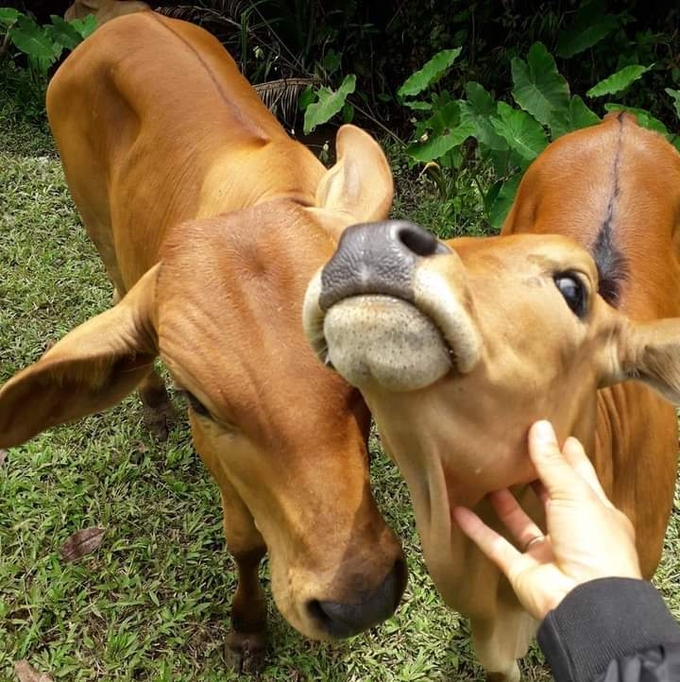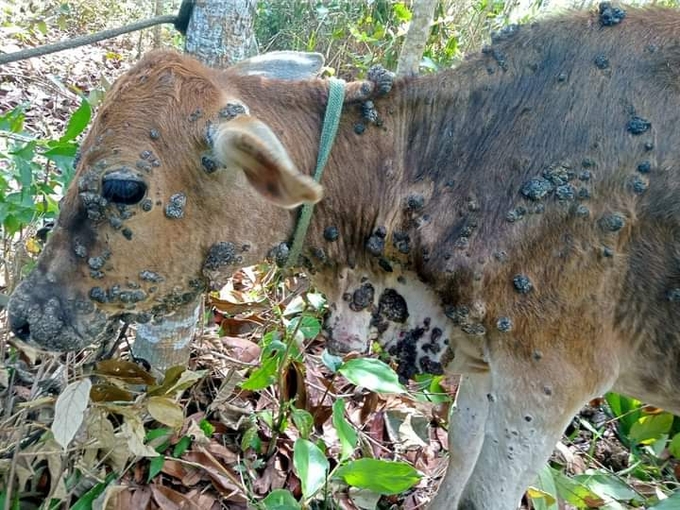May 21, 2025 | 06:38 GMT +7
May 21, 2025 | 06:38 GMT +7
Hotline: 0913.378.918
May 21, 2025 | 06:38 GMT +7
Hotline: 0913.378.918

When it comes to free-ranging cows of ethnic minorities in Vinh Thanh district (Binh Dinh), before vaccination, veterinarians have to pat them to calm them down and keep them still. Photo: V.D.T.
According to Director Le Van Thuan of the Agricultural Service Center of Vinh Thanh district (Binh Dinh), this district has a total herd of approximately 18,000 cows, 1,000 buffaloes, more than 17,000 pigs, and nearly 110,000 chickens. Having such a large herd of poultry and cattle, the district’s veterinary force feels lacking. There are only 2 district-level veterinary officers, while 9 communes and towns in the area still have "holes" in the veterinary force.
Many of Vinh Thanh’s communes are located very far from the district center plus difficult roads. This is something the veterinary team in this mountainous district has to deal with constantly. To give an example, Vinh Son commune is located 50km from the center of Vinh Thanh district along the pass, and Vinh Kim commune is also nearly 40 km from the district center.
The villages are also located very far from the commune center. Because the village veterinary system has no longer been operating since the beginning of September 2023, the total livestock and poultry herd of nearly 150,000 heads in Vinh Thanh district now depends on the commune veterinary system.
The veterinary force of this locality currently has 9 people, enough to arrange for each commune and town to have 1 veterinary officer. The person with the lowest level of expertise is an intermediate veterinary officer. Looking from the outside, the commune-level veterinary staff in Vinh Thanh is filled, but there is still a “hole” in Vinh Hao commune. The veterinary staff of this commune lacks professional qualifications considering the regulations of the Ministry of Agriculture and Rural Development.
“Despite our thin force, like other localities in Binh Dinh province, the veterinary force of Vinh Thanh district still takes the vaccination duty very seriously. Avian influenza vaccine is administered continuously. Foot-and-mouth disease vaccine on buffaloes and cows is administered twice a year, and the vaccine to prevent lumpy dermatitis and pasteurellosis is administered once a year. We also have to regularly monitor the status of livestock production in the area to grasp the disease situation,” said Director Le Van Thuan.

Cows raised freely in a semi-wild style in the mountainous district of Vinh Thanh (Binh Dinh) suffered from lumpy dermatitis, but the disease situation is now under control. Photo: V.D.T.
Dinh Dang, one of the veterinary officers of Vinh Kim commune (Vinh Thanh district), describes the path the team must travel to get to the vaccination site as unimaginably difficult. “From the center of Vinh Kim commune, if you want to get to O2 village at Konhlon peak, you have to walk or ride a motorbike through a very high, steep mountain pass. The path to O3 village is similarly difficult. It takes 2 hours to get there. Meanwhile, going to O2 village takes exactly a full day”.
Ethnic minorities in O2 village raise cows a lot. When going for vaccination, veterinary staff have to carry a foam box containing the vaccine on their back. O2 village has a divided terrain, so farmers cannot gather livestock to one point for vaccination. Veterinary staff have no choice but to carry the foam box from one point to another.
The story of Truong Trong Huy, a veterinary officer of Vinh Son commune, gives out the same sense of frustration. Almost all ethnic minority households in Vinh Son commune raise cows, but they do not raise them in barns like the people of the plains. Even if there are some livestock barns, it is poorly constructed. It is common to see livestock roaming freely in the forest. Wherever there is a large field of land, the farming households put all their cows there. To perform vaccination, the veterinary team must go deep into the forest to reach the animals.
Cattle in mountainous areas are raised in a semi-wild style, with little contact with human, so they still have full of wildness in their blood. The benign cows that the owner raises can be tied to a forest tree so that veterinarians can vaccinate them, but in other cases, some cows are so ferocious that even the owner does not dare to approach them, let alone the veterinary officers, who are complete strangers to the animal. Huy, an experienced veterinary officer, almost had his arm and leg broken several times. He was even seriously injured by a bull once.
“Those who have been trained in veterinary know how to avoid kicks from cows, but sometimes ferocious cows would jump in circles and break my legs when I try to inject the vaccine. In cases where the veterinary officer injects vaccine for a calf, the mother cow feels anxious and rushes in to protect the calf. It is a very dangerous job indeed,” said Huy,
Translated by Samuel Pham

(VAN) Japan's grant aid project contributes to capacity building, promoting organic agricultural production, and fostering sustainable community development in Dong Thap province.

(VAN) For years, the CRISPR-Cas9 genome technology has been reshaping genetic engineering, a precision tool to transform everything from agriculture to medicine.

(VAN) Vietnam aims to become a 'leader' in the region in the capacity and managing effectively soil health and crop nutrition.
![Reducing emissions from rice fields: [Part 1] Farming clean rice together](https://t.ex-cdn.com/nongnghiepmoitruong.vn/608w/files/news/2025/05/05/z6509661417740_a647202949c539012a959e841c03e1d3-nongnghiep-143611.jpg)
(VAN) Growing clean rice helps reduce environmental pollution while increasing income, allowing farmers to feel secure in production and remain committed to their fields for the long term.
/2025/05/19/5136-1-144800_230.jpg)
(VAN) The Nghe An Provincial People's Committee has just approved the list of beneficiaries eligible for revenue from the Emission Reductions Payment Agreement (ERPA) in the North Central region for the year 2025.

(VAN) 14 out of 35 domesticated elephants in Dak Lak province have had their living conditions improved, with 11 of them currently participating in the non-riding elephant tourism model.

(VAN) Muong Nhe Nature Reserve hopes that being upgraded to a national park will lay the foundation for forest protection efforts to be carried out in a systematic, modern, and sustainable manner.